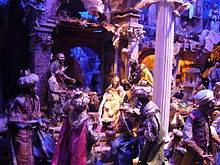
Back مغارة الميلاد Arabic مغارة الميلاد ARZ Belen BCL Шопка Byelorussian Kraou Nedeleg Breton Pessebre Catalan Jesličky Czech Julekrybbe Danish Weihnachtskrippe German Φάτνη της Γεννήσεως Greek


In the Christian tradition, a nativity scene (also known as a manger scene, crib, crèche (/krɛʃ/ or /kreɪʃ/), or in Italian presepio or presepe, or Bethlehem) is the special exhibition, particularly during the Christmas season, of art objects representing the birth of Jesus.[1][2] While the term "nativity scene" may be used of any representation of the very common subject of the Nativity of Jesus in art, it has a more specialized sense referring to seasonal displays, in particular sets of individual sculptural figures and props that are arranged for display.
Other characters from the nativity story, such as shepherds, sheep, and angels may be displayed near the manger in a barn (or cave) intended to accommodate farm animals, as described in the Gospel of Luke. A donkey and an ox are typically depicted in the scene, and the Magi and their camels, described in the Gospel of Matthew, are also included. Many also include a representation of the Star of Bethlehem. Several cultures add other characters and objects that may or may not be Biblical.
The first living nativity scene, attributed to Saint Francis of Assisi, occurred in 1223 in the Italian town of Greccio. Francis had been inspired by his visit to the Holy Land, where he had been shown Jesus's traditional birthplace.
Distinctive nativity scenes and traditions have been created around the world, and are displayed during the Christmas season in churches, homes, shopping malls, and other venues, and occasionally on public lands and in public buildings. Nativity scenes have not escaped controversy, and in the United States of America and in secular countries like France, their inclusion on public lands or in public buildings has provoked court challenges.